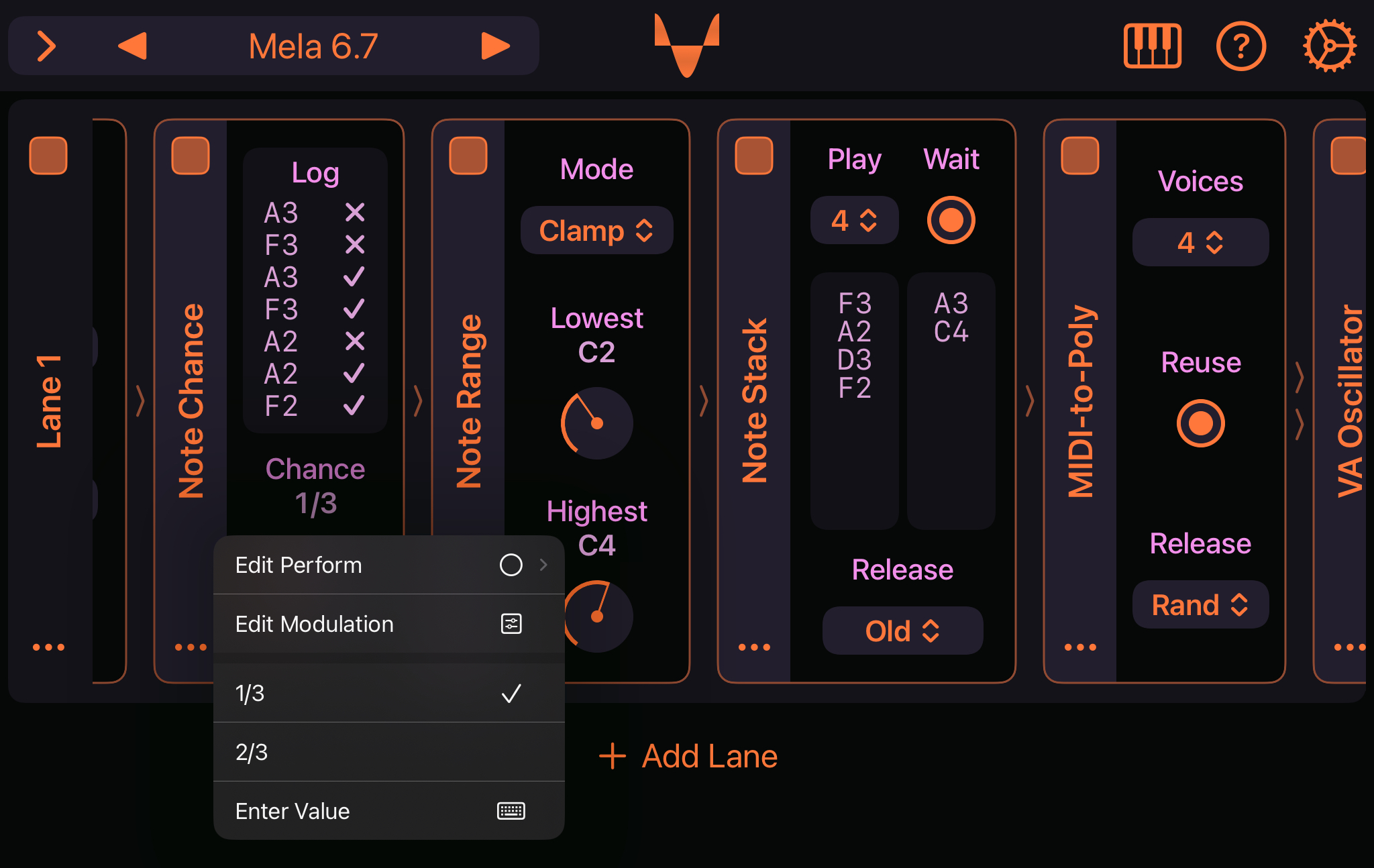Mela 6.7 Update – Adds Features to Note Processors and More
Mela 6.7 adds many useful features to the Note Stack, Note Pulse, and Note Range modules. The Mono module has been generalised into the Note Stack module. It can now stack more than one note, making it useful not just for monophonic but also polyphonic synths. It also enables creative use in MIDI Processor chains. Note Pulse now offers three modes: Once, Hold, and Loop. Loop mode behaves as before. Once mode is great for resyncing LFOs, and Hold mode is useful for auto-starting the Euclid module’s sequencer. Note Range adds a new Clamp mode, notes outside the range are clamped to the nearest valid note.
Parameter interaction has been dramatically improved in this version. First, there’s the new Parameter Presets system. Offset parameters can be set to Triplet (~66.7 %) or Dotted (150 %), with a checkmark and label shown instead of a numeric value. Some parameters also include “Set to …” menu items for quickly entering common values. These behaviours have now been unified. For example, one of the Note Chance module’s presets is “1/3” instead of 33.3 %, and VA Filter’s Frequency includes a C3 preset that sets the cutoff to ~262 Hz.
Entering parameter values is now far more flexible. You can type in values using seconds, milliseconds, hertz, kilohertz, beats, or bars, and they’ll be converted automatically. For example, delay time can be entered in hertz or LFO frequency in milliseconds. You can also use fractional beat values like “4/1”, “2/5”, or “1/4T”, and even enter MIDI note names like “C4”, “D#-1”, or “Gb3” to set frequency-based parameters.
There’s a lot more in this update. For the full details, check out the Changelog.

Latest Tutorials
The video highlights new features in Mela 6.7, including updates to the Note Stack, Note Pulse, and Note Range modules. It also introduces the new Parameter Presets feature and demonstrates the enhanced flexibility of parameter value entry.
The following video gives a quick overview of the new features in Mela 6.6, including the Note Hold module, enhancements to the Feedback module, new Group modes, various UI improvements, Poly Audio buses, and the Flip-Flop modulation signal.
Why should I get Mela? What’s so special about it?
I saw a few people around the web ask this question. I thought I’d address it here. Simply put, Mela is a modular music-making tool that scales with your needs. Expanding on this, its 3 core strengths are:
- Mela is Visual and Modular. With its intuitive interface, you can seamlessly build fully custom polyphonic synthesisers, unique audio effects, and complex MIDI processors.
- Mela Scales. It can be a core part of your system or a small utility to let you perform niche tasks. Mela can run as a standalone app or multiple plug-in instances in a host, on macOS and iOS.
- Mela has Great Support. Its capabilities continuously improve, evolve and expand. A new version of Mela comes out every few weeks with new features and modules designed around user feedback.
Artist Presets & Themes
There are dedicated pages for Artist Presets and Artist Themes. If you have created Mela presets (whether paid or free) or a theme you want to share with others let me know and I’ll happily link them there.
About Me
Hi, my name is Nikolozi Meladze. I’m the creator of Mela. I’m developing it as my primary tool for music-making and live performance. I’ve been releasing music since 2010, exploring all sub-genres of electronic music. Be sure to check out my discography.
